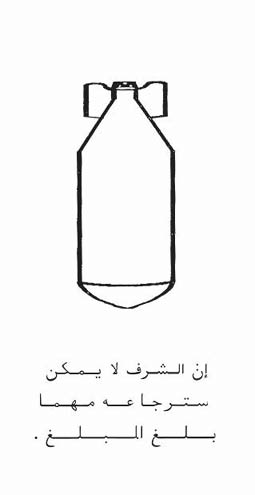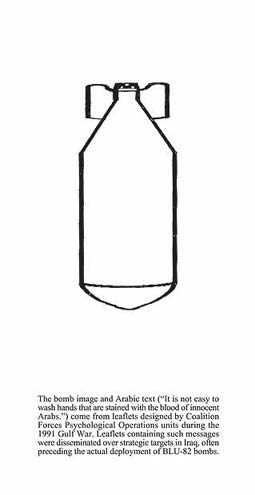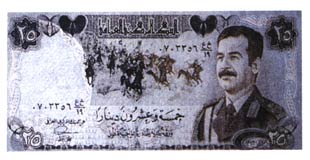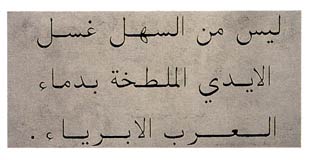
IF / THEN : The Leaflet Project
Excerpts from The Leaflet Project Outline
for 2008 ZERO1 in San Jose, US of A
The "IF/THEN" Leaflet Project consists of two components: "IF/THEN: You Decide" and "IF/THEN: Honor Will Never Be Regained"
As a whole, the work confronts and examines the particulars of inter-cultural mass communication in the context of military conflict. Focusing on the leaflet format, issues of language and mechanics of contemporary propaganda are explored. By deploying, in the domestic environment, of the information distribution strategy intended for the theater of military operation, "IF/THEN" aims to provoke a social and cultural introspection, and reflects on the relationship between high- and low-tech "expressions" in the "information age."
BACKGROUND and CONTEXT
1. Propaganda
a/ Society is heavily saturated with political manipulation. Every individual act or gesture has political ramifications, regardless of whether it takes place in public or private. Members of every society need to understand their own position and role in it, and meaningfully reflect on the relationship between the individual and collective.
b/ Recent history powerfully underscores the need for artists and cultural agencies to become directly involved in the social dialogue. In the time of political crisis the quality of discourse diminishes: argumentation becomes crass, polarized and intellectually impoverished. Art has the capacity to introduce depth, richness, detail and complexity to the discussion of urgent and important issues.
c/ Pursuing principles of propaganda in the process of experiencing and/or making art accomplishes a number of goals. It can empower the work of art to deliver its idea in a more forceful, efficient and accurate manner. It can facilitate a much broader communication platform for artists and audiences.
2. Leaflets
a/ According to "Psychological Operations Field Manual No.33-1" published in August 1979 by Department of the Army Headquarters in Washington DC: "A leaflet is a written or pictorial message on a single sheet of paper. It has no standard size, shape, or format. In selecting the size, shape, and weight of the paper, the primary consideration is that the paper accommodate the message and be easy to distribute. The recommended size, provided the message can be accommodated, is a 15.24 centimeters by 7.72 centimeters (6 by 3 inches) on 7.25- or 9.06- kilogram paper (16- or 20-pound). Leaflets of this size and weight have very favorable aerial dissemination characteristics."
b/ I have embraced the format of a leaflet a number of years ago, producing small editions of leaflet for a number of applications: from pragmatic objectives of information dissemination, to constructing self-contained messages embracing the leaflet format as an art-object. (See the Leaflet Archive) Regardless of the intended use, I am always aware of, and actively engage with the rich historical and functional character of the format itself. In the "IF/THEN" Leaflet Project I am further exploring the position of the leaflet object: the type of messages it delivers, and language it employs in the contemporary world.
THE PROJECT
1. Content
At the heart of the project is a series of printed leaflets. These are printed in full color (when applicable) and according to the PSYOP standards (see above). Specifics of the designs and the key visual and textual elements of the leaflets are based on designs used by the Coalition Forces in the military operations in Iraq and Afghanistan. The general premise being centered around the idea of re-positioning, disrupting and/or re-directing this peculiar (leaflets and Psychological Operations in general) communication process. The research is based on the current PSYOP materials and leaflets deployed in recent history.
An example of this exploration is a recently produced Labor Camp leaflet "It's Not Easy":
|
 |

|
| front |
back
|
|
In which the Arabic text and the image of the bomb had both been reproduced from two separate Coalition forces leaflets to construct a new message, this time intended for American audience.
It is somewhat difficult for us to not think of leaflets as an archaic mode of communication. It seems that the idea of a leaflet seems to belong in a grainy black and white footage of World War II. In the age of mass media, satellite television, Internet and email, dropping pieces of paper from an airplane does not seem like an efficient way to distribute information. Yet the recent US military campaigns in Afghanistan and Iraq, as well as the earlier Persian Gulf War waged massive Psychological Operations involving hundreds of millions of leaflets. Objectives of a well designed and skillfully deployed propaganda dwell on a thorough understanding of the target audience and its culture. From that standpoint the printed matter provides a more appropriate platform for the specifics of the specific military theater of operations. The written messages, slogans, argumentation and imagery all are crafted for the carefully defined audience. They also, in an oblique way reflect on the author of the messages and our culture.
I am interested in exploring the ideas, tension, dialectics and poetics involved in the act of cross-cultural communication utilizing the leaflet as a key point of connection and an information carrier. Some ideas central to my investigation include:
a/ Vernacular/Language:
(Language of Psychological Operations; Clarity and Forcefulness of Message vs. Ambiguity and Poetry.)
I am interested in the specific of the language used in the leaflets, but also in propaganda in general. I am especially focusing on particular conceptual and language formations frequently used in military designs. An example of such unique statement is the original "If/Then" model exemplified by this Coalition Forces leaflet, which served as the basis for the Labor Camp "IF/THEN: You Decide" leaflet series:
|
|
|
Or this infamous 25 Dinar note leaflet developed by Central Command (CENTCOM) during the Gulf War, which became the basis for the Labor Camp "IF/THEN: Honor Will Never Be Regained" leaflet set:
|
 |

|
| front |
back
|
|
b/ Cultural Exchange:
(Political and Cultural infections by means of leaflet drops; Cultural Imperialism; Projecting ideological messages: from US to THEM, and/vs. from THEM to US.)
To what extent does the method of delivery reflect the message? How does the weight of American ideas intended for Iraqi audience resonate in the domestic context?
c/ Means and Methods:
(High and low technologies in mass communications.)
Attacks of 9/11 had been accurately described by someone as "low-tech, high-concept". Can one draw a parallel between comparison of 9/11 attacks vs. high-tech weaponry (e.g. Unmanned Aerial Vehicle) attacks, and leaflet drops vs. Internet and digital information technologies?
2. Dissemination
During the 2008 ZERO1 festival in San Jose the "IF/THEN" Project is implemented in two main patterns:
Outdoors
(Disseminating the set of six "IF/THEN: You Decide" leaflets)
Message Force Multiplier Instruments are affixed to selected architectural fixtures in locations throughout the Festival/Event grounds. The Device boxes are suspended at medium heights (beyond the reach of a person on the ground: approximately 9-10 ft) from selected buildings (indoors and/or outdoors) throughout the Festival area. Each device is equipped with a small motorized and automated release system, which releases single leaflet at a particular set time interval. Cleanup crews would be alerted to the locations and scheduled pickup of excess leaflets at particular intervals. The outdoors implementation would be a short-term presentation: mounted for the duration of specific events.
Indoors
(Disseminating the two "IF/THEN: Honor Will Never Be Regained" leaflets)
Two Message Force Multiplier Instruments are installed at the San Jose Museum of Art for the duration of "Superlight" exhibition.
The devices are suspended at the highest available point (but always beyond the reach of a person positioned on the ground) in the given space. The two Devices are mounted along the near-ceiling line, facing each other, and dispensing leaflets into the gallery space. The Indoors presentation is intended as an extended duration format, and can be sustained within a traditional gallery exhibition format. Re-filling and maintenance of the Devices displayed within the exhibition space can be facilitated by trained gallery staff or crew.
Additional materials:
Leaflet designs for the "IF/THEN: You Decide"
Leaflet designs for the "IF/THEN: Honor Will Never Be Regained"
Songs From Above a series of 20 micro sound compositions based on texts from archival leaflets.
piotr szyhalski
(Excerpts from Draft 2, Nov. 2007)
�
|
|